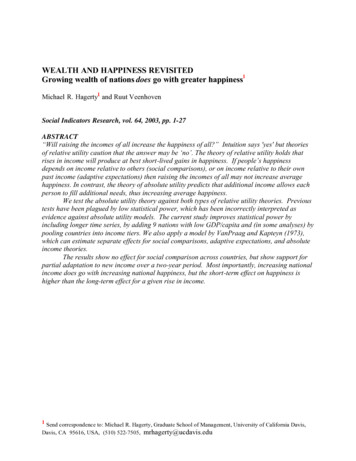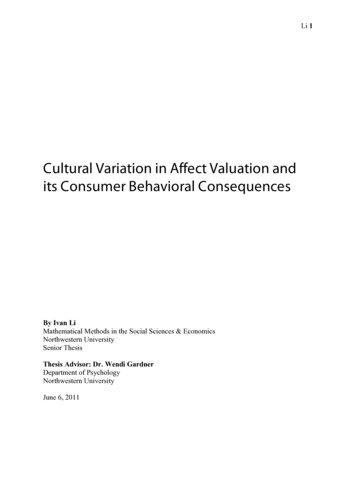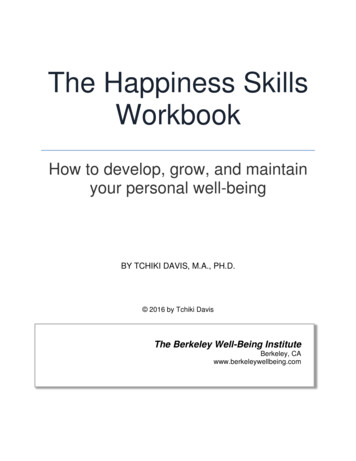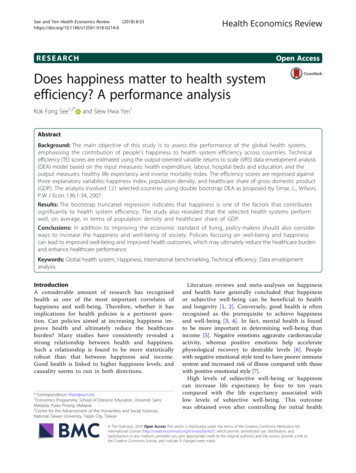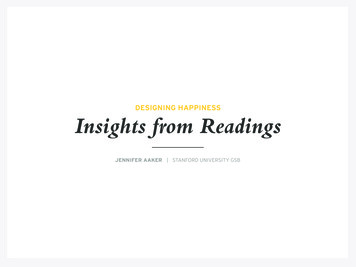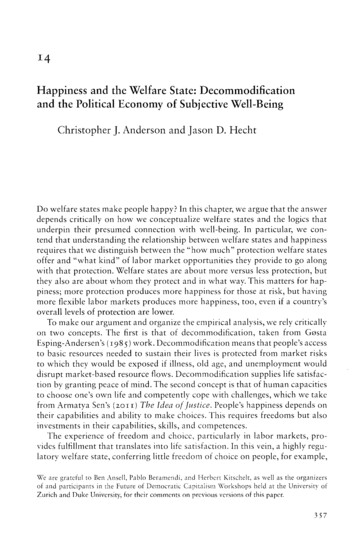
Transcription
Happiness and the Welfare State: Decommodificationand the Political Economy of Subjective Well-BeingChristopher J. Anderson and Jason D. HechtDo welfare states make people happy? In this chapter, we argue that the answerdepends critically on how we conceptualize welfare states and the logics thatunderpin their presumed connection with well-being. In particular, we contend that understanding the relationship between welfare states and happinessrequires that we distinguish between the "how much" protection welfare statesoffer and "what kind" of labor market opportunities they provide to go alongwith that protection. Welfare states are about more versus less protection, butthey also are about whom they protect and in what way. This matters for happiness; more protection produces more happiness for those at risk, but havingmore flexible labor markets produces more happiness, too, even if a country'soverall levels of protection are lower.To make our argument and organize the empirical analysis, we rely criticallyon two concepts. The first is that of decommodification, taken from GostaEs ping-Andersen's (198 5) work. Decommodification means that people's accessto basic resources needed to sustain their lives is protected from market risksto which they would be exposed if illness, old age, and unemployment woulddisrupt market-based resource flows. Decommodification supplies life satisfaction by granting peace of mind. The second concept is that of human capacitiesto choose one's own life and competently cope with challenges, which we takefrom Armatya Scn's (2orr) The Idea of Justice. People's happiness depends ontheir capabilities and ability to make choices. This requires freedoms but alsoinvestments in their capabilities, skills, and competences.The experience of freedom and choice, particularly in labor markets, provides fulfillment that translates into life satisfaction. In this vein, a highly regulatory welfare state, conferring little freedom of choice on people, for example,\X'e are grateful to Ben Ansell, Pablo Beramendi, and Herbert Kitschelt, as well as the organizersof and participants in the Future of Democratic Capitalism \'('orkshops held at the University oiZurich and Duke University, for their comments on previous versions of this paper.357
Christopher]. Anderson and Jason D. Hechtin labor markets, may generate less life satisfaction than a freedom-inducingwelfare state, even if decommodification is equally high. So instead of moredecommodifying welfare states simply making all or most citizens a bit happierthan less decommodifying ones, different kinds of welfare states also create distinct sets of more or less happy citizens across countries. As a result, variationsin aggregate happiness are driven by both the quantity of social protection andthe extent to which they allow flexibility for v.rorkers seeking opportunities inthe labor market.The two-dimensional account of the welfare state and its implications forlife satisfaction resonates directly with the scheme developed in the editors'Introduction to this volume. Political economies vary in the extent to whichgovernments intervene in market processes, for example, by building encompassing welfare states, and thus absorb risks, with the potential to improvethe life satisfaction of those most exposed to market risks. But political economics also allocate differential resources to people's investment in capabilities to innovate and adjust to future developments (especially education andresearch), when compared to the effort that supports people's current consumption and replacement of market income (unemployment and sicknessbenefits, pensions). And it is more investment-oriented polities that also tendto have lighter regulation of employment, as they empower citizens to deploytheir skills in coping with the risks of the market economies in which they live.We take it, therefore, that where polities make greater investments in citizens' skills that allow them to make occupational and lifestyle choices people are likely to be happier. In other words, life satisfaction should be highestin polities that combine encompassing welfare states (state intervention) withlight regulation of labor markets and people's empowerment through skill formation (investment orientation), while it should be lmvest where welfare statesare residual and combined with tightly regulated labor markets (consumptionorientation).We begin with a careful look at correlations among decommodification,employment regulations, and happiness at the macrolevel, and then proceedwith a more rigorous account of how welfare states shape reports of subjective well-being at the microlevel - a question that has received relatively littleattention in previous comparative research on the welfare state and happiness.To make our argument, we first provide a brief overview of research on theconnection between decommodification and happiness.' Second, we attemptto reproduce macrolevel relationships among decommodification, employmentregulations, and happiness. We find evidence of a positive correlation betweendecommodification and happiness, as well as a negative correlation betweenstrict employment regulations and happiness. Third, in an effort to highlightthe specific mechanisms at work that connect \velfarc states to happiness, weTo our knowledge. no previous scholarship has specificalh· examined the link bct\\Ten emplovment regulations and happiness.
Happiness and the Welfare State359turn our investigation to reports of subjective well-being at the individual level.We find that the interaction of decommodification and employment regulations with specific individual-level characteristics can have marked effects onreports of subjective well-being. Fourth and finally, we conclude with a discussion of happiness research in comparative politics, as well as the implications of our results in light of the recent economic misfortune that has plaguedWestern Europe and the OECD.14. r. Welfare States and Happiness: Is More Better?Citizen support for the welfare state is at least partially reflective of the degreeto which people demand social protection. Extensive comparative politicsresearch on support for the welfare state suggests a host of factors that potentially shape demand for the welfare state at both the individual level (e.g.,Kitschelt 1994; Iversen and Soskice 2001; Moene and Wallerstein 2001; Rueda2005; Rehm 2011b) and the macrolevel (e.g., Korpi 1983; Iversen and Soskice2006; Brooks and Manza 2007; Lupu and Pontusson 2011; Beramendi 2012;Rehm, Hacker, and Schlesinger 2012). Each of these accounts provides its ownstory of why support for the welfare state varies, but a common thread concerns the various forms of social risk, in particular, the risk of income lossindividuals or groups of individuals confront.Speaking generally, individuals at a higher risk of income loss demandhigher levels of social protection from the state and therefore express higherlevels of support for the welfare state. Presumably if or when those demandsare met, however extensive they may be, individuals experience an increasedsense of well-being because of the security provided by the extension of a socialsafety net. This version of the story of the relation between vvclfare states andhappiness answers that welfare states make people happy when social risks aremitigated, although the level of happiness is contingent on a number of factorsat the individual, group, and even national levels.A related logic supporting a link between the welfare state and happinessconcerns the capacity for the welfare state to "decommodify" citizens fromthe perils of the modern marketplace. Defined more precisely, labor can beconsidered decommodified to "the degree to which individuals, or families,can uphold a socially acceptable standard of living independent of market participation" (Esping-Andersen 1990: 37). In a strong view of this perspective,where labor force participation essentially reduces individuals to nothing morethan commodities, the idea that the welfare state can make individuals happier by shielding them from this fate can be considered self-evident (Pacek andRadcliff 2008).Work in this area has focused correlations at the macrolevel and is chieflyconcerned with the deleterious effects that economic insecurity can foist oncitizens competing in the labor market (Radcliff 2001). A long and illustrious line of political economists including Marx, Polanyi, and Lindblom
Christopher]. Anderson and Jason D. Hechthas discussed this negative externality of wage labor under capitalism. Therelationship between decommodification and happiness can therefore beinterpreted as stemming from welfare states' function as an antidote to thestress and anxiety caused by work in the modern world (Radcliff 2001; Pacekand Radcliff 2008).Consequently, states that provide higher levels of decommodification (etceteris paribus) through their welfare states should possess citizenries thatare on average happier than states providing lower levels of decommodification. Consistent with these ideas, and regardless of the logic one may prefer,an emerging macrolevel literature on the relationship between welfare statesand happiness has found a correlation between welfare state effort and happiness (Radcliff 2001; Pacek and Radcliff 2008; DiTella, MacCulloch, andOswald 2003).These empirical findings and the theoretical priors that underpin them arenot without critics. Veenhoven (2000) in particular doubts the relationshipbetween the welfare state and happiness, arguing that, after controlling for acountry's affluence, higher levels of social protection fail to equalize happinessoutcomes among a country's citizenry, with countries that provide higher levelsof decommodification possessing no more equal happiness distributions thancountries with lower levels of decommodification (Veenhoven 2000).Veenhoven's primary argument posits a kind of crowding out effect whenit comes to social protections provided by the state. He contends that greatersocial protections do not necessarily imply greater social protections for society as a whole because state-provided protections may not be of higher qualitythan those provided by private organizations (Veenhoven 2000). In addition,he argues that the security gained from increased welfare provisions may beoffset by a loss in individual freedoms, or by diminished economic growth thathe finds elsewhere to be correlated with higher levels of happiness (Hagertyand Veenhoven 2003 ).We take Veenhoven's critique seriously and agree that welfare states thatoffset higher levels of protection with restrictions on individuals' freedoms inthe labor market may ultimately have a negligible impact on citizens' life satisfaction. The trouble with Veenhoven's critique is in the empirical testing of theargument; his results hinge critically on the use of raw social security expenditure data as a proxy for welfare state effort, an approach that has fallen outof favor with scholars of the welfare state (Pacek and Radcliff 2008). In addition, he fails to test his hypothesis explicitly regarding the deleterious effect ofSocial spending (i.e . welfare state effort! as a measure oi welfare state gcnerosin· has been critiqued for its inabilin· to paint an accurate picture oi the welfare state's influence on citizens' liiechances {e.g . Scruggs and Allan 20061. For example. social spending tends to increase duringperiods of economic downturn. This does not necessarih· mean that a welfare state has becomemore generous. Rather, it ma,· simph· indicate that social spending has risen as more and morepeople come to rely on entitlements because of unemployment or income loss.
Happiness and the Welfare Stateflexibility loss on expressions of life satisfaction. We remedy these empiricalshortcomings in two ways. First, we utilize Scruggs's decommodification index(Scruggs 2004), which quantifies and updates Esping-Andcrsen's (1990) original decommodification formulation and provides more precise measures forseparable welfare state institutions (see also Scruggs and Allan 2006). Thisexercise is similar to that performed by Pacek and Radcliff (2008 ), who reassess the relationship between decommodification and happiness with Scruggs'sdata and find a positive and statistically significant relationship between welfare states and happiness. Second, we test the flexibility loss hypothesis by utilizing a measure of employment regulation strictness developed by the OECDand made available in the Comparative Political Data Set I (Armingeon et al.2012). By controlling for employment regulations and decommodificationsimultaneously, we enable ourselves to evaluate better how social welfare protections and labor market flexibility combine to shape expressions of life satisfaction cross-nationally.Our chapter then tackles both an empirical as well as a theoretical question. On an empirical level, the question is this: How robust is the relationshipbetween welfare states and happiness? The theoretical question follows: Whyis (or is not) there a correlation between decommodification and happiness?Moreover, if it docs exist, are decommodification and labor market flexibilitytwo of the primary mechanisms responsible for connecting welfare state institutions to happiness? We take up each of these questions in turn.14.2.Exploring the Welfare State-Happiness Link EmpiricallyThe dependent variable examined in this paper is a measure of people's quality of life in the form of subjective well-being (i.e., happiness). Psychologistsalso variously refer to this construct as life satisfaction or happiness, whileeconomists on occasion also have labeled it "experienced utility" (for reviews,see Diener, Suh, Lucas, and Smith 1999; Frey and Stutzer 2002). The literature on subjective well-being is wide and deep and covers a wide variety ofsocial sciences (e.g., Radcliff 2001 ).3 Suffice it to say, for present purposes,Given the varied social science traditions that haw explored the foundations of subjectivewell-being, it should be no surprise that happiness has been attributed to myriad different sourcesby researchers, although these sources have been debated and evolved over time. \'Vil son's (19 67)study on the correlates of "'arnwed happiness," one of the earliest significant works of happinessscholarship, stressed that happiness is largelv driven by psvchological factors within indi,·iduals.For \X'ilson, a happy person is "niung, healrhy, well-educated, well-paid, cxtro,·erted, optimistic.worrv-free. religious, married person with high self-esteem, job morale, modest aspirations, ofeither sex and of a wide range of intelligence" (\'Cilson 196r 294). Today research on subjectivewell-being tends to focus less directlv on the correlates of happiness, and more on the processesand environments that tend to lead to happiness (Diener ct al. 1999\.Still. factors found toinfluence subjective well-being varv from hvpertension (Blanchflowcr and Oswald 2008ai, toreligious devotion (Ellison I 991 ), to goal setting behavior (Brunstein 199 Ji. Material conditions
Christopher]. Anderson and Jason D. Hecht3628.5eswi oe,.Den Den Ire Swi8 se K7.5 s Swe Aut Ace lium. e:!!ii!f'llut Fin Nld Nor Fi Fin SNld Belwe Nzl GerSwe or UK lta 1ta CM er Ger Fra7 Fra Fra lta6.52010304050Decommodification Life Satisfaction (mean)FIGURE 14. r.cies,Fitted valuesDecommodification and life satisfaction in seventeen OECD democra-1981-2000.that the validity and reliability of indicators measuring subjective well-being(SWB) have been extensively researched. 4 In the following, we use two standard indicators measuring life satisfaction (one on a r-rn scale, the other on ar-4 scale) (for question wording, sec Appendix) from the World Values Surveysand Eurobarometer surveys, respectively.To begin our assessment of the robustness of the relationships amongdecommodification, employment regulations, and happiness, we first examine the correlation between decommodification and happiness with the helpof World Values Survey data for seventeen countries from r98 r to 2000' in ascatterplot presented in Figure r 4. T. We have superimposed a linear trend lineto orient the reader.4have been shown to influence subjective well-being, with people in richer countries reportinghigher levels of happiness, all else equal (Cantril 1965; Inglehart 2000; DiTella and :\lacCulloch2008: Pacek and Radcliff 2008 I. Reports of subjective well-being also seem to follow a U-shapedpattern throughout the course of indi,·iduals' lives (Blanchflower and Oswald 2008: .\ndersonand Hecht 201 l ), with the trials and tribulations of middle age apparentlv depressing happinessduring those years.For well more than two decades, psRhologists ha,·e extensi\-elv researched the validitv andreliabilitv of different happiness indicators (for a re,·ie\\·, see Frev and Stutzer 2002: see alsoSandvik, Diener, and Seidlitz r991 I. In an earlier sur,·n· of research on subjecti,·e well-being.Diener II 984 I concluded that·· [the] measures seem to contain substantial amounts oi nlid ,-ariance" (p. 5 51) (see also the survey about various measures oi subjective well-being by Andrewsand Rohinson r99rl.\Ve are prevented from extending our analrsis past 2002 by the lack of availabilitr oi decommodification data beyond that point in time.
Happiness and the Welfare StateA careful inspection of Figure 14. r reveals a couple of notable characteristicsof the relationship between decommodification and happiness. First, there isa moderately strong and positive correlation between them. Second, certaincountries fit this relationship better than others. While countries at the highend of happiness such as Norway and Sweden seem to fit relatively well, others such as Ireland, Italy, France, and Canada seem to fit relatively poorly. Inthe case of Ireland and Canada, which can be located toward the middle- toupper-left portion of the scatterplot, individuals are happier given the levelof decommodification than the regression line would predict. In contrast, forFrance, Italy, and Germany, which can be located toward the lower-left andlower-center portions of the scatterplot, individuals are somewhat less happygiven the level of dccommodification.While these two groups of outliers do not diverge enough to obviate thepositive correlation between decommodification and happiness, they arc ofparticular note because they group nicely along Esping-Andersen's worldsof welfare capitalism: Ireland and Canada are prototypical examples of liberal welfare states in Esping-Andersen's classification scheme, while France,Germany, and Italy represent conservative welfare states. Thus the continentalEuropean democracies such as France, Germany, Austria, and Switzerland defythe positive trend between decommodification and happiness. While this resultis puzzling at first, it becomes less so when we investigate scatterplots thatdemonstrate the relationship between employment regulations and happinessat the country level.Figure 14.2 plots the same World Values Survey life satisfaction data againstemployment regulation strictness data from the OECD discussed previously.Here we observe a relatively strong negative correlation between employment regulations and life satisfaction, with the United States, United Kingdom,Ireland, and Canada locating in the upper left, combining low levels of employment regulation with moderate levels of happiness. In contrast, countries suchas France, Germany, and Italy locate in the lower right, indicating high levels ofemployment regulation paired alongside low levels of happiness.This finding may provide initial insight as to why the continental Europeancountries fit the decommodification-happiness trend so poorly. Specifically,although this group of countries provides a relatively high level of decommodification for its citizens, that decommodification appears to be offset bystrict employment regulations that are correlated with lower expressions ofhappiness. While this evidence is merely descriptive, it does indicate that thereis not a "one size fits all" story with regard to the relationship between welfare states and happiness. Although welfare states providing higher levels ofdecommodification seem to lead to happier citizens, those that simultaneouslyrestrict labor market flexibility through strict employment regulations appearto offset those gains as a result of stringent employment regimes. We proceedto a more robust assessment of these correlations in the next section of thechapter.
Christopher]. Anderson and Jason D. Hecht8.5eswi Den Ire Deneswi8 Aule FinI §eSw eNzleuK UKeUK7.5 swe ut1e111ree AusNldNo, Nor Bel Ger Bel Ger Ger Ilae1ta Fra7 Fra6.52034Employment Regulations (Higher Values Indicate Greater Strictness) Life Satisfaction (mean)FIGURE 14.2.racies,- - - Fitted valuesEmplovment regulations and life satisfaction in seventeen OECD democ-1985-2000.14 The Welfare State and Happiness at the MacrolevclThe true test of the connection between welfare states and happiness, and ourability to judge the debate that has evolved regarding the dual mechanisms ofdecommodification and flexibility reduction, requires a more sophisticated analytic strategy. Thus, utilizing Eurobarometer data we proceed with a replicationof previous analyses of the relationships among decommodification, employmentregulations, and happiness, where we investigate the correlation between the twophenomena while controlling for GDP growth, the unemployment rate, the rateof inflation, a year counter to control for any time trend that might be present, andpopulation. To gain additional confidence in these macrolevel findings, we alsoestimate models with the addition of dummies accounting for Esping-Andersen'sthree worlds of welfare capitalism." We utilize ordinary least squares (OLS) regression to estimate our model, calculating robust standard errors due to heteroskedastic errors caused by repeated country observations (e.g., Hamilton 2009 ). Theresults are reported in Table T 4. T .71'Our assignment of countries to Esping-Andcrsen's worlds of welfare capitalism is as follows. \'\'cclassifr Ireland and the United Kingdom as liberal welfare states. \'Ce classifr Denmark, hnland, Jorway, and Sweden as social democratic ,,·elfare states. finall\", we classit\" Austria, Belgium.France, Germany, !rah·, and the :\erherlands as consen·ati\"e welfare stares. See Esping-A.nderscn1990, chapter 2 and Esping-Andersen 1999, chapters 4 and 5.Our anal\"sis here closch· mirrors that of Pacek and Radcliff (20081. Our anah-sis has a slighrhlowcr number of observations (2 r 5 vs. 242). However we include twelve rather than elevencountries (Norwa\" being the addition I, and our anah-sis extends back five more years (to 1970rather than 1975).
'-"0\, ,,(.128)1630.677 · 7 .006)-.008""(.002)- . I l ,, ,.,,.019'""'"(.003)Model 3(3.976)1630.792 2. l ''"''"(.003)-.008(.006)-.009"""(.002)-.003'"·:· :·(.ooo)-.129t(.068)-.202"''""(.036)Model 4(4.522)1630.73.202"""(.038)l 8 .4 ,,.,, ,,. I "(.003).002(.006)-.008""(.002).019 ''-·· .,.Model 9)Model 8)(.003)-.003 t(.002)(.003)-.021·· '· ,,.-.008(.006)-.025';.,.,,.Model 7Note: The results me OLS regression estimates and their robust standard errors (in parentheses): I/; .ro,"« .05, '"' .or,'"'"''« .oorR'Number of observationsConstantSocial on rateUnemployment rateGDP T(.003)-.133 '·' ,, ,,.(.002)-.183 ,,.,,.,,.Employment regulations.0 l 6 ndependent variablesLife SatisfactionTAB LE l 4. r. Country-level determinants of life satisfaction in twelve european democracies: eurobarometer data.8'"'."(2.83 5)2150.78I 28 8 ,.,,,,.Model 8
Christopher]. Anderson and Jason D. HechtThe first notable finding is that the results demonstrate a strong and positive correlation between decommodification and happiness even after theinclusion of the employment regulation variable and the other controls. Thiscorrelation is somewhat stronger in Model r than in Model 2 after the inclusion of the population variable, an unsurprising result given that decommodification and population are correlated (-o. 5 r level). In addition, the negativerelationship between employment regulations and happiness we observedearlier continues to be robust. The unemployment rate shows a statisticallysignificant and negative correlation with happiness in both models, a resultthat fits with our expectations about the effect of rising unemployment onhappiness at the macrolevel. The time trend parameter is also statisticallysignificant and negative, indicating a slight decline in happiness over timeduring our sample period. Finally, the population parameter in Model 2 isnegatively correlated with happiness. This fits with patterns that we observedpreviously with regard to Scandinavia, which routinely demonstrated thehighest levels of happiness but are countries with relatively low populations.Thus far then our intuitions about the relationships among decommodification, employment regulations, and happiness have proven correct. States thatprovide higher levels of social protection tend to have happier citizens, whilestates that restrict labor market flexibility tend to depress reports of life satisfaction somewhat.In Models 3 through 8 decommodification and employment regulationagain take their positive and negative respective signs and are generallyhighly statistically significant. The lone exception to this is Models 4 and 6,where the decommodification parameter takes the appropriate sign but failsto achieve conventional levels of significance, a result that can be attributedto the highly correlated population parameter in these model specifications.Consistent with Models r and 2, Models 3 through 8 also demonstrate thatthe unemployment rate, time trend, and population parameters are negatively correlated with happiness. Overall, the models including worlds of welfare capitalism dummies produce no significant deviations from the resultsobserved in Models r and 2 in terms of the parameters that are constantacross the set of models.Turning our attention to the worlds of welfare capitalism dummies themselves, two points salient to our analysis become apparent. First, of the threewelfare worlds, social democratic welfare state types perform the best. InModels 3, 4, 7, and 8 social democratic welfare states serve as the referencecategory, and both the liberal and conservative parameters take negative signsand arc statistically significant, with the exception of the liberal welfare stateparameter in Model 3. When social democratic dummies are included in themodel specification and conservative welfare states sen-e as the reference category (Models 5 and 6), the social democratic dummies both take positive signsand arc significant at the p .oor level.
Happiness and the Welfare StateThe second notable point concerning the welfare state dummies included inTable 14.r is that controlling for decommodification and employment regulations at the country level appears to account for a substantial amount of thehappiness-producing capacities of the various welfare state types. This can beobserved most clearly by comparing the welfare state parameter estimates ofModels 3 and 4 with those of Models 7 and 8. Model specifications 7 and8 omit the decommodification and employment regulation parameters, andwithin these models the welfare state dummies nearly double in magnitude 8and are all significant at the p .05 level or better.In particular, the decommodification and employment regulation parameters appear to do an especially good job of accounting for discrepancies in happiness between liberal regimes and the other two welfare state types. In Models3 and 4, the liberal dummy, which provides a comparison between liberal andsocial democratic welfare states, is only significant at the p . ro level in Model4, and insignificant in Model 3. In contrast in Models 7 and 8, which omit thedecommodification and employment regulation parameters, the liberal dummyis significant (at p .05 or better) in both models. This denotes that there is asignificant difference between the liberal and social democratic welfare statetypes in terms of happiness, but that difference is only manifested clearly whendecommodification and employment regulations are not accounted for. Liberalregimes also exhibit no statistically significant difference from conservativeregimes when controlling for decommodification and employment regulations,as is the case in Models 5 and 6.Beyond these results based on Eurobarometer data, we also reestimatedidentical models with the help of data from the World Values Survey (WVS).This allows us to evaluate the decommodification-happiness, employmentregulation-happiness relationships using an alternate measure of happinessthat has a different scale ( ro point versus 4 point). Moreover, the WVS dataprovided a wider cross section of countries that can be evaluated, as countriesfrom North America and the Asia-Pacific region are included. As the results inTable 14.2 show, the negative employment regulation-happiness correlationremains consistently strong across these models. T
regulations, and happiness. We find evidence of a positive correlation between decommodification and happiness, as well as a negative correlation between strict employment regulations and happiness. Third, in an effort to highlight the specific mechanisms at work that connect \velfarc states to happiness, we






